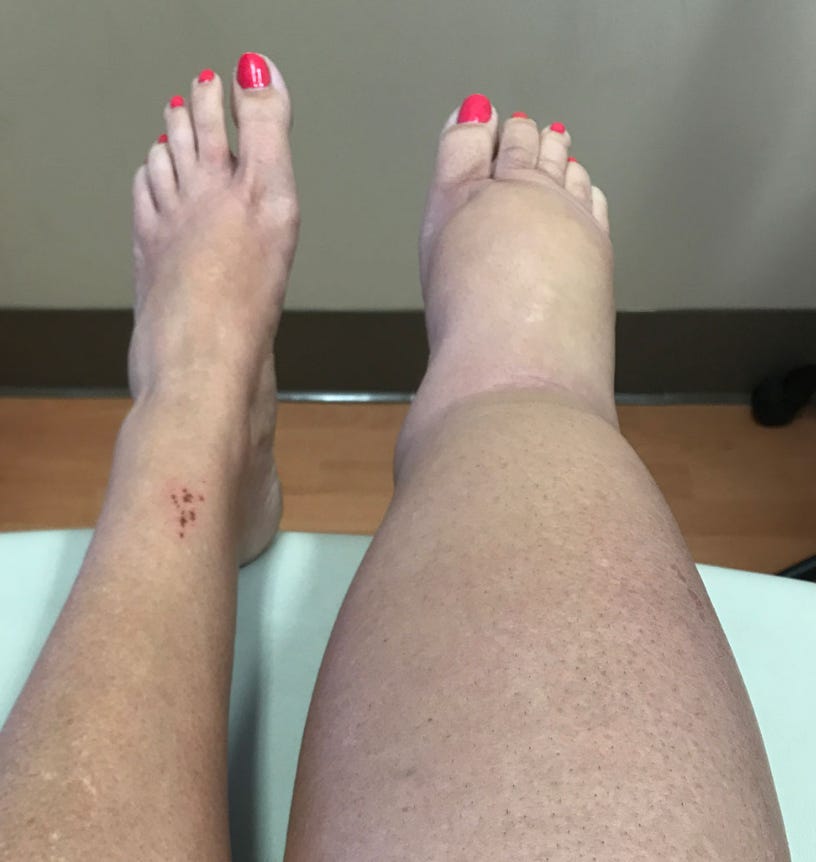What's the Difference Between Lymphedema and Lipolymphedema?
Here's a breakdown of both conditions
Please note all information I provide is for education and discussion only. I’m not a medical doctor, and this is not medical advice. For further information, please read my medical disclaimer. Thank you!
Hi Everyone!
We typically get misdiagnosed with Lymphedema when we try to get help for our condition. That’s because, whereas Lymphedema is very well-known, lipolymphedema is not; hence, it’s mistaken for Lymphedema.

What is Lymphedema?
Primary Lymphedema can start at a very young age; the cause is typically due to a genetic condition. It affects a body area, such as the leg or arm. Lymphedema can also happen secondary to cancer and cancer treatment, such as surgery and lymph node removal, radiation treatment, or tumor blockage.
Secondary Lymphedema also called edema, is caused by organ failure, primarily heart, lung, and liver disease or venous insufficiency. Secondary Lymphedema may be in more than one limb (i.e., from heart failure) or in the abdomen, which is called ascites (especially from advanced liver disease).
What is Lipolymphedema?
Lipedema swelling is technically called Lipolymphedema. This swelling is on both sides of the body, typically in the lower body (although can also be in the abdomen and arms), and can be present in as low as Stage 2 Lipedema. Many women discover they have Lipolymphedema through an assessment for chronic venous insufficiency (CVI) or varicose veins (this is why a vascular surgeon is a good resource for Lipedema diagnosis).
Here’s a comparison:
Lipolymphedema
Swelling is symmetrical
Feet or hands are usually not affected
Limbs bruise easily
Skin is soft and supple without thickening
Pressure doesn’t leave indentations
Pain in tissue with pressure
Swelling is soft to touch
The risk of infection is no more significant than average
Affects women only
Losing weight isn’t effective
Familial history of women’s side
Lymphedema
Swelling may be unequal
Feet are frequently affected
Limbs do not bruise easily
Affected skin is thickened
Pressure will leave an indent
No pain with pressure
High risk of infection
Affects men and women
Losing weight can help
Family history in 20% of cases
And if that isn’t confusing enough, I’ll add it in grid form (you may have to enlarge this if you’re reading on your mobile):


Many physicians are unaware of Lipolymphedema and misdiagnose it as Lymphedema or obesity. They just don’t see the difference in swelling from Lipolymphedema.
However, once you see the difference, you can’t unsee it.
The most important reason I write about this is to show you the difference. This knowledge gives you ammunition for the next time you are questioned by a medical professional about your increased leg mass. Most doctors and others in medicine DO NOT know about Lipolymphedema, yet will use their medical expertise to sway the diagnosis towards Lymphedema or Obesity. Don’t doubt yourself in these situations; you know more about your disease than they do.
The burden is on educating others about our disease, even those who work in medicine. We should not feel ashamed about our bodies or our condition. The more we advocate for ourselves, the more Lipedema will become as well-known as breast and ovarian cancer or any other woman-related illness.
Take care,
Michelle
Find me on TikTok! I share snippets of information about Lipedema, liposuction, and medical insurance.
Go to the Lipedema and Me page on Facebook! This is a new page, so join me there!
Consult with me! Set up a time to talk one-on-one about your surgical treatment and how to start your surgical journey.




